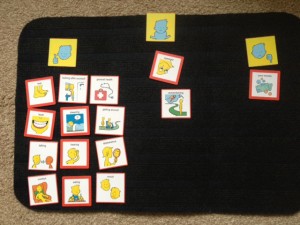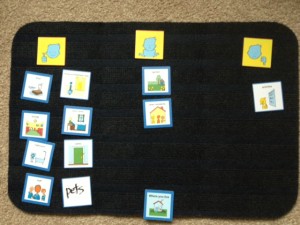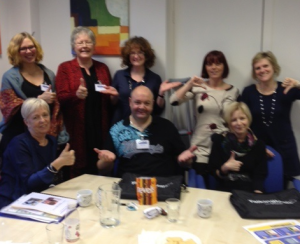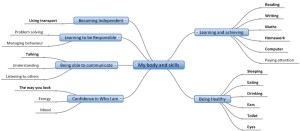Guest Blog by Ruth Cape
Ruth is Lois Cameron’s daughter and she has contributed the following guest blog about her recent experience of taking and passing her driving test and how using a Talking Mat the night before her test developed a nerve controlling action plan!
My Driving test -a nerve wracking prospect
Even the simplest of actions within the context of a nerve-wracking event can be magnified to stomach churning proportions. The thought of opening a car door and putting on a seatbelt has never before given me much trouble. Now suddenly I’m imagining fumbling with the handle, not finding the seatbelt lock – or worse, forgetting the thing altogether; while trying to look cool and collected in front of a reportedly ‘no-benefit-of-the-doubt’ driving test examiner. It was the night before my practical driving test. I had recently failed on a nerves-getting-the-better-of-me manoeuvre and knew I’d be unlikely to get another test for 3 months if this one didn’t work out. I live on the Isle of Harris. Winter gales make cycling difficult, if not often impossible. Winter busses are sporadic. My housemate-cum-chauffeur-cum-co-driver had just left the island. My driving lessons in Stornoway required a four hour round trip. To put it lightly, I was pretty keen to pass. If I’m honest, even if I knew I could get another test the next week and if my day to day life wouldn’t be much effected by the use of a car, simply the thought of 40 minutes in that vehicle-turned-pressure-cooker, every move scrutinised by a stranger in a high-vis would have given me the tangled stomach I suffered from that test eve.
Talking Mat trialled as a pre-driving test nerve-gatherer
Timing was on my side this time round; my mum – Lois – and her colleague – Sally – happened to be on a Talking Mats training visit to Stornoway that pre-test day. Finished with a day of training, we met for dinner and, as plates were cleared away and calming herbal tea was ordered, out came the pen, paper and post-it notes. This – I gather – was the first Talking Mat trialled as a pre-driving test nerve-gatherer; proving just how versatile a tool it is. With a top-scale to gauge my confidence levels, different aspects of the test were handed to me and ended up in a cluster around the lower two steps of the scale; opening the door and putting on my seatbelt sat just a little above parallel parks and three point turns. While this mostly went to show that it was the whole experience that was knotting my insides, it allowed a valuable opening for discussion on how to go about unknotting, or at least concealing the knots.
Reframing thoughts and strategies for success
Re-framing the nerves to focused adrenalin, positive mantra, power posing and deep breaths – the mediation of the Mat provided the opportunity to work through strategies for success. I went to bed, glad – at least – to have had something to do to that evening to channel the nervous energy. The following morning I opened that car door, put on my seatbelt and proceeded to pass with one minor. Now, I can’t allow Talking Mats to take all the credit for this turn of events, but I can definitely praise the tool and thank my two informal practitioners for keeping me focused. From this experience, I’m sure there is potential for a wider Talking Mats scope for tackling anxiety and for use in relation to stressful situations.
Now Harris has opened up, and I’m off to explore…
When I went back to the Care Home where I was piloting our new Social Care symbols the staff told me this story about Ann (see previous blog). Apparently she usually is very quiet and never joins in with activities or with other residents. However when we used Talking Mats with the Activitiies symbols, she told me that she really likes singing and had started singing to me. Later that day, one of the care staff had suggested that she sing again and Ann started a song with him. Gradually other residents joined in and they had a lovely sing-song with Ann leading it!
On another day I used the Social Care symbols with Dorothy who tends to go off track and repeat stories over and over. She was quite sure about what she liked and didn’t like about the Care Home and using Talking Mats was a gentle and easy way to bring her back on topic.
I recently used the ‘Talking Mats Social Care’ pack in a Care Home with 3 residents, Ann, Barbara and Colin, who all have dementia. Neither Ann nor Barbara were wearing their glasses but all three were able to see and recognise the symbols and use Talking Mats to express their views. All three conversations took place in the lounge where the TV was on, staff were moving around and and where other residents were chatting.
Ann, whose mat is at the top of this blog, used the ‘Activities’ set and very quickly understood what to do although at times she needed to be reminded what the top scale meant. She said she was a very happy person and didn’t think I would find anything that she didn’t like but as we went through the symbols she became more thoughtful and said that she did not like DIY, exercise or knitting and sewing. She used the mid-point to indicate the things she used to enjoy but does not do now. She was delighted when she saw how positive her overall mat was.
Barbara used the ‘You’ set to tell me how she felt about herself. Although she could have placed the symbols, she preferred to sit back, tell me what she thought and let me place them for her. She felt fairly positive about most things although she was aware that her eyesight and her memory were not as good as they used to be. She also joked that she never had enough money.
Colin has dementia and is also profoundly deaf. He has only recently moved into the care home so we used the ‘Where you live’ set of symbols. Colin said several times that he didn’t think there was any point in having a conversation as he can’t hear. However after writing down the reason for doing it, he gradually realised that he could use the symbols to understand what I was asking and then express himself. He said he was generally happy with the Care Home although he missed his garden and found it hard to make friends now as he cannot hear what the other residents are saying. He also felt there are not enough activities that he can take part in. He mentioned that he has a pet dog but doesn’t know what has happened to it since he moved. One of the staff said he would try to find out. He seemed satisfied with the final mat and staff felt it would be useful to use Talking Mats more with him to reduce his isolation.
The following are thoughts from Jenni, a Psychologist who attended the Talking Mats Accredited training course.
‘Meeting with five colleagues from Sweden, England and various parts of Scotland for the accredited Talking Mats Training this month has been a fascinating experience. I have been accustomed to using Talking Mats with children and young people over the past seven years, and have seen the value of the approach in helping young people give their views for a meeting – particularly if they have communication difficulties and would struggle either through lack of confidence or skill to speak out when others are present.
However, we were not just a group who work with children and young people. Most came from health settings and examples were drawn from elderly patients, some with dementia, others with autism. As we shared our videos and told our stories it was obvious to me how relevant Talking Mats can be in those settings too. Some of the stories shook me. One person told how she was deep in conversation with a lady over her Talking Mat when the tea lady burst in, poured a cup of tea for the resident, asked if she was having a good time playing at puzzles, then left before any answer could be given. Time and again we found ourselves asking what is it about our institutions that puts routines above real communication and above proper respect for an individual.
In preparing a video to bring to the training I undertook a Talking Mat with my father, who is almost 90. It was a new kind of conversation for us both, but we were surprised – the structure allowed us to talk about what was going well and what needed a bit of an adjustment in domestic life and we both learned from the conversation. I think we will do it again!
Indeed, at one stage in the training we were asked to dream big and look at how we might want to take use of Talking Mats into new areas. I identified some good friends – one 91, one 101 and one 104 – where conversation can become rather one-sided. I am interested in the power of Talking Mats to help create a genuine dialogue when these friends are reminiscing, in other words, to help me to be not just a listener but to enter the dialogue. Having a record of the conversation will help us take the discussion further when we return to it.
As ever, the time spent with Talking Mats colleagues was refreshing, stimulating and I can’t wait to go home and try out some new ideas!’
Jenni Barr, Educational Psychologist
Thank you Joan and Sally for the fantastic hospitality and inspiring 2 day accredited train the trainer course at Stirling university.
I cant wait to carry out our first session with all of the fabulous advice and support materials you have given us. Talking mats can reopen doors to communication that others may fear were closed for ever.
I was so lucky to meet a group of lovely people on the course, who also share the same enthusiasm for using Talking Mats. It is absolutely fantastic to be part of something that is world wide and getting bigger, long may you reign and long live Talking Mats.
Anthony Howe, Assessor/Tutor/Internal verifier
Training and Development Team, Adult Social Care
Tyne and Wear
Accredited training in Stirling
In the end of October, I pushed my bad flying-nerves aside and travelled from Stockholm to Stirling to attend the Accredited Training Course at Talking Mats. It was two intensive days where we, a small group of six people, in a structured way learned about and had the chance to try out different aspects of teaching Talking Mats. It was interesting to hear the other participants’ experiences with Talking Mats. Both Joan and Sally who held the course were encouraging and enthusiastic. Doing all this in English made me a little bit dizzy at the end of the days, but nonetheless I came home with a lot of new perspectives and ideas I will try on my colleagues in my first own training session next year. Please have a look at my Evaluation Mat!
Liv Thalén
Speech and Language Therapist
The Karolinska University Hospital, Stockholm
During the final stages of developing Digital Talking Mats, we invited some people with aphasia and their partners to come and try it out for us. I spent some time talking to Matthew, who has severe global aphasia and dyspraxia. Matthew loves having a chat, but relaxed conversation can be a challenge because Matthew finds it difficult to generate language and sometimes his yes/no responses get mixed up. I used the ‘activities’ topic with Matthew to have a chat about the things he likes (and doesn’t like) doing. Matthew found the Digital Talking Mats easy to use and quickly gave me his views about activities. Using the i-pad made the conversation feel very natural, and Matthew was able to convey his sense of humour – when I asked him about Church; Matthew started to sing the Funeral March! We had quite a laugh about this, and it turned out that at the moment, Matthew really only goes to Church when there is a funeral. Matthew was also able to tell me about things that he finds difficult since his stroke, such as reading and doing DIY. During our conversation, I was struck by how equal the conversation felt. Matthew was able to express his views without feeling pressurised to think of words. I was able to ask Matthew open questions without worrying that I might not understand his responses. Using Talking Mats on the i-pad was easy and relaxed. I could imagine using it with Matthew to have a chat over coffee or at the pub. Perhaps we should think of some conversational symbol sets?
To see Matthew using the app, click here
Attending one of our standard training courses will:
- Provide you with a range of practical tools and models that will help you evaluate a person’s ability and their level of support required
- Give you a holistic framework to support people with communication disability
- Build your confidence in using Talking Mats
- Encourage your creativity in using and applying Talking Mats in different situations such as goal setting, sharing views, supporting disclosure, enabling decision making…..the list is endless!
You can either
- Book places on our regular courses held in different venues across the UK
- Book a bespoke training for your organisation
- Participate in our 12 week online training course
However, you cannot train others unless you have completed and passed one of our residential ‘train the trainers’ courses. We put significant emphasis on our accredited training because without it, the quality and integrity of the Talking Mats framework is diluted and damaged.Talking Mats is based on extensive research and although it may appear simple, there are many complex layers involved in using it and we need to be confident that trainers have an in depth knowledge and understanding of these.
In order to apply to become a Talking Mats trainer you have to have completed the standard training (above), be experienced in using Talking Mats and fulfil the course requirements.
Intellectual Property
Talking Mats was originally developed at University of Stirling and the Intellectual Property is held by the University and Talking Mats Limited is assigned the sole rights to Talking Mats. Talking Mats is registered as a trademark. Only training that is sanctioned by us is recognised and anyone training others without being a recognized Talking Mats trainer is infringing Intellectual Property and copyright.
Signposting and sharing knowledge
We are of course delighted when people share their knowledge and experience of Talking Mats and signpost others to the website and resources.
We wanted to develop a tool that would give a holistic picture of how a child or young person feels about their lives at home at school and in their communities. We took into account the significant developmental changes that occur from 3 to 17 years and the influence of environmental and personal factors surrounding the child or young person.
We asked our artist to reflect the age and stage of the child in developing a symbol set for:
- Early years
- Primary and
- Secondary
The symbols are organised into three topics:
My Body and Skills: In this section you explore how the child is growing and developing by focussing on the functions of the body as well as skills that are emerging. You can gain an impression of how the child feels he or she is progressing physically, socially, cognitively and behaviourally.
What I do and my support: In this section you look at the child’s lived experience by asking about the activities they participate in, as well as how they feel about the support they receive.
My Wider world: The communities in which children grow up have a significant impact on the well-being of both children and families. In this section you look at the child’s wider world by exploring the impact of nursery or school as well as the support system available to them.
Talking Mats prompts you to cover the relevant topics for each age group you’re working with. You can help children and young people to see their personal strengths and abilities and take time to consider what their problem areas are.
The mind map below shows what is included in the Primary pack – What I do and my support.
If you want to read about how Talking Mats were used to help young people think about targets for their IEP read the 2012 research report.
If you would like the complete Consulting children and young people pack, covering Early years, Primary and Secondary then buy the silver resource which can be purchased either as an original or through a digital subscription.
By Dr Norman Alm, School of Computing, University of Dundee.
Have been thinking for some years – and having dialogues with Joan Murphy – about this : would it be possible to come up with a new type of AAC where both the non-speaking person and their communication partner(s) were equally in joint control of some sort of system? Imagine a touch screen which also could be controlled by switch input. A non-speaking person and their communication partner are both engaged with the screen and both equally making use of it to do … what ?
Don’t know at the moment, but there are several suggestions for ways to explore and develop this idea further. Talking Mats is one.
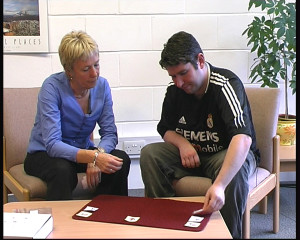
The purpose is to help the person with communication difficulties express their opinions, with the other participant being a facilitator. But notice what is not happening – a face-to-face interview. Instead both participants look away from each other and focus on the mutual task, manipulating the symbols on the mat to produce the communication. Much less stressful – and much more enjoyable and productive. Another example is the CIRCA system, which supports what is usually problematic communication between a person with dementia and a carer or relative. The support takes the form of touchscreen access to an engaging multimedia display of reminiscence material drawn from public archives. Again a potentially stressful and unproductive face-to-face encounter is converted into an enjoyable mutual activity that flows effortlessly. The design of each of these systems taps into something powerfully motivating. Talking Mats lets the person describe their emotional reactions to a subject, as manifested by the scale which organises the elements on display into a snapshot of that person’s individual feelings. CIRCA makes use of the one faculty still operative even in quite advanced dementia – the ability to recall long-term memories and enjoy sharing them.
Both these systems offer a structured communication encounter in which the structure has the effect of not restricting, but freeing up the communication. Crucially ( I would argue) both free the participants from the direct responsibility of keeping the interaction going and let them share that responsibility with a third agent.
 Online training login
Online training login 

